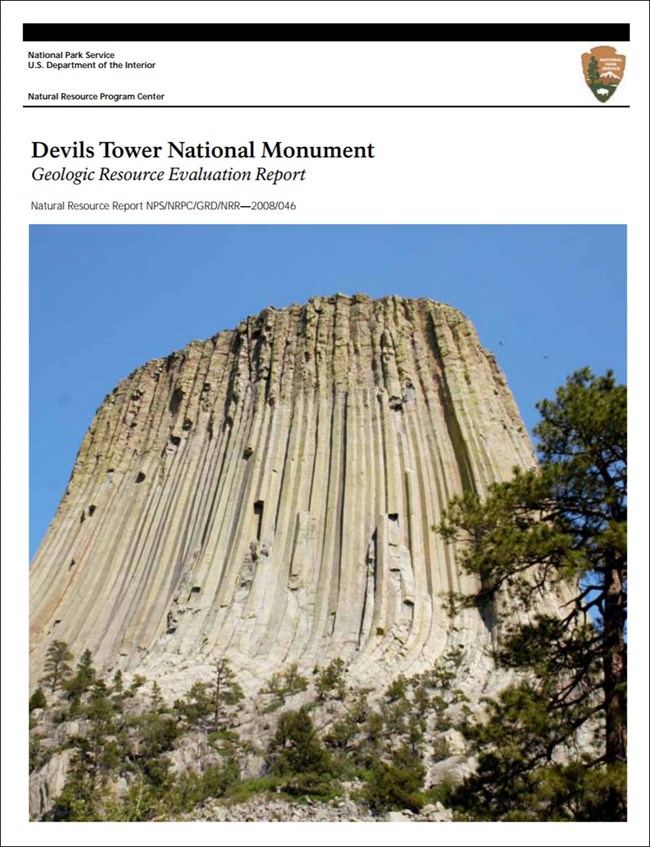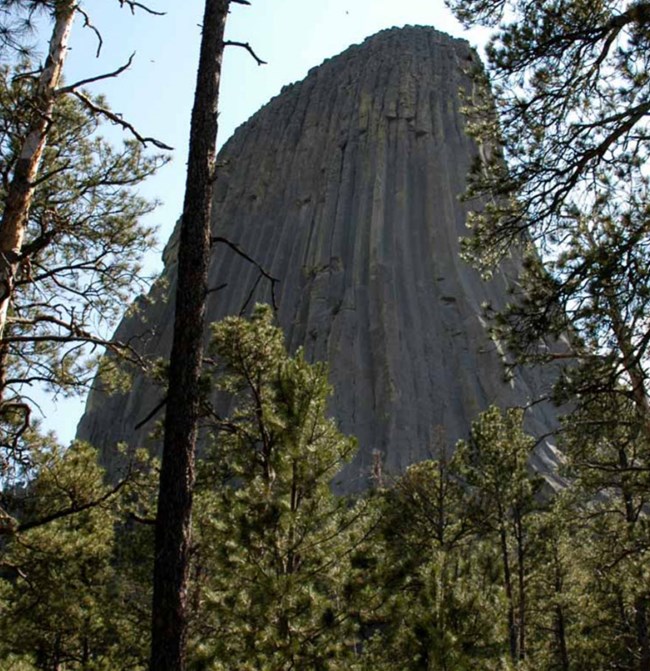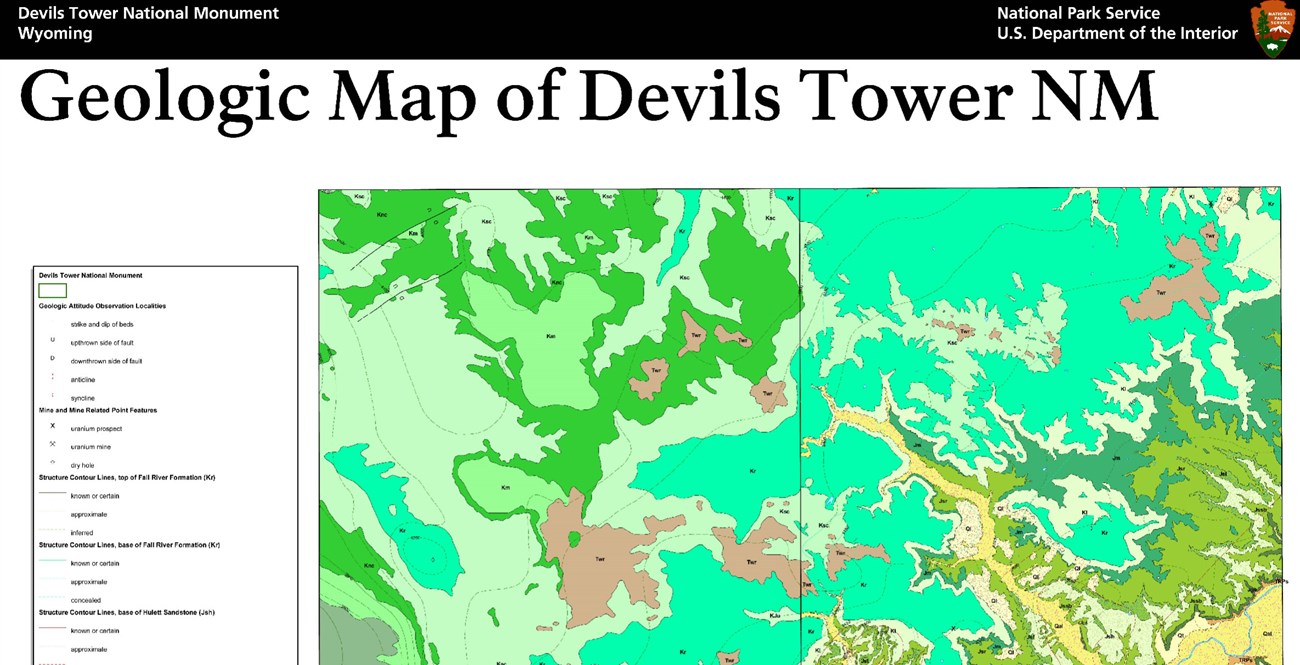Last updated: June 17, 2024
Article
NPS Geodiversity Atlas—Devils Tower National Monument, Wyoming
Geodiversity refers to the full variety of natural geologic (rocks, minerals, sediments, fossils, landforms, and physical processes) and soil resources and processes that occur in the park. A product of the Geologic Resources Inventory, the NPS Geodiversity Atlas delivers information in support of education, Geoconservation, and integrated management of living (biotic) and non-living (abiotic) components of the ecosystem.

Geologic Features and Processes
Devils Tower National Monument, in northeast Wyoming, is the nation’s the first national monument, established by Theodore Roosevelt in 1906. Devils Tower is a steep sided igneous monolith recognized worldwide for a spectacular geologic feature known as columnar jointing. It is also the most widely known landmark of the northern Great Plains. Elevation at the relatively flat summit of Devils Tower is 1,560 m (5,117 ft) above sea level (Karner and Halvorson 1987, 1989; Kiver and Harris 1999). The top of the Tower measures about 55 m (180 ft) from east to west and about 91 m (300 ft) from north to south (Robinson 1956). Devils Tower rises about 386 m (1,267 ft) above the north-flowing Belle Fourche River, which is responsible for excavating the buried igneous feature and continues to cut away at its south flank.
Devils Tower is located on the northwest flank of the Black Hills, an uplift formed during the CretaceousTertiary mountain-building episode called the Laramide Orogeny that occurred about 45–65 million years ago (Ma). The Black Hills form a 105 by 200 km (125 by 65 mi) elliptical dome, or doubly plunging anticline, that is elongated in a north–south direction (Kiver and Harris 1999). This forested mountain range in southwest South Dakota and northeastern Wyoming covers approximately 2 million acres. Erosion has removed the Paleozoic and Mesozoic strata from the central axis of the dome, exposing Precambrian rocks that make up the core of the uplift. The younger sedimentary rocks of Paleozoic and Mesozoic age form concentric rings around the Precambrian core.
Phonolite Porphyry
The crystalline igneous rock that composes Devils Tower is classified as phonolite porphyry. Phonolite is a type of fine-grained igneous rock composed primarily of the mineral feldspar. A ‘porphyry’ is a rock that has coarse crystals surrounded by fine-grained material, or groundmass. The groundmass of fresh specimens is lightto dark-gray or greenish-gray and contains conspicuous crystals of white feldspar that are about 0.6–1.3 cm (0.25– 0.50 in) in diameter and smaller very dark-green crystals of pyroxene, a group of dark rock-forming silicate minerals. Weathered surfaces appear light gray or brownish gray and lichens may give the phonolite a green, yellowish-green, or brown color.
Columnar Jointing
The world-renowned polygonal columns are one of the most striking features of Devils Tower. In the middle part of the Tower, the columns are bounded by well-developed smooth joints, but as the columns taper upward, the joints between them may be wavy and some of the columns unite. Cross-fractures in the upper part of the Tower form many small irregularly shaped blocks.
The fractures are about 120° to each other and form 4 and 6 sided columns. The larger columns measure 1.8– 2.4 m (6–8 ft) in diameter at their base and taper gradually upward to about 1.2 m (4 ft) at the top. In the central and upper parts of Devils Tower, the columns are almost vertical. However, they flare out at the bench about 30 m (100 ft) above the base, and they are nearly horizontal on the southwest side. Several columns may join to form a larger, less distinct column that merges with the massive base where the columns flare out.
Columnar joints form when shallow igneous bodies quickly cool. The fractures are a result of differential contraction during cooling because solidified rock requires less volume than molten rock.
Talus Apron
An apron of talus (eroded blocks lying at the base of the cliff), landslide material, and the remnants of a large volume of alloclastic breccia (a coarse-grained sedimentary rock formed by volcanic processes) surround the Tower. Debris from the Tower and the Hulett Sandstone Member of the Jurassic Sundance Formation comprise the talus and landslide material. The talus sheet radiates outward from the tower about 335 m (1,100 ft). Near the base of the Tower, talus is about 46 m (150 ft) thick, but it thins rapidly away from the monolith (Karner and Halvorson 1989). Talus fragments range from a few centimeters in diameter to large sections of the columns as much as 2.4 m (8 ft) in diameter and 7.6 m (25 ft) long (Robinson 1956). Within the talus sheet, three outcrops of phonolite may be radiating dikes (igneous intrusions shaped like a table top turned on edge) or part of the original uneroded igneous mass.
Origin of Devils Tower
Four general hypotheses have been proposed for the origin of Devils Tower.
-
Devils Tower is an erosional remnant of a volcanic neck. In this hypothesis, the volcano vented to the DETO Geologic Resource Evaluation Report 23 surface through more than a hundred meters (several hundred ft) of sediments (Carpenter 1988; Dutton and Schwartz 1936; Halvorson 1980; Karner and Halvorson 1987, 1989).
-
Devils Tower is a remnant of a laccoltih or sill (Jagger 1901; Darton 1901).
-
Devils Tower is an intrusive igneous body, such as a small pluton (Robinson 1956).
-
Devils Tower lies in a depression that is the remnant of a crater formed during an explosive volcanic episode when rising magma encountered meteoric groundwater. Devils Tower is the erosional remnant of the lava and hot pyroclastic material that filled this crater (Kiver and Harris 1999).
The nearly vertical columns in the center of Devils Tower and the outward flaring columns elsewhere around the base could have formed as part of a volcanic neck, shallow intrusion, or a sloping basin surface. However, apparent discrepancies still exist for all of the origin hypotheses.
Sedimentary Rocks
Red, yellow, green, or gray sedimentary rocks compose the hills in the vicinity of Devils Tower. These beds of sandstone, siltstone, shale, and gypsum are about 122 m (400 ft) thick. The oldest unit is the Triassic/Permian Spearfish Formation (fig. 4). The Spearfish Formation is overlain by Jurassic strata. Although no Cretaceous or Tertiary sedimentary rocks are exposed in Devils Tower National Monument, Cretaceous strata and the Oligocene White River Formation are present in the Missouri Buttes, smaller bodies of columnar-jointed igneous rock exposed northwest of Devils Tower (Robinson 1956; Karner and Halvorson 1989).
The Permian, Triassic, and Jurassic red siltstone and sandstone sedimentary strata form rolling hills and gentle slopes because the units are poorly cemented and weather easily. Recent erosion caused by the Belle Fourche River and its tributaries has exposed the current topographic expression of the tower. The alluvium, glacial materials, and other surficial deposits of Quaternary age fill major drainages in the area and continue to be deposited in a continental environment.
Paleontological Resources
Clams, oysters, belemnites (squid), and other marine fossils are known from the Redwater Shale Member of the Sundance Formation, but no fossils have been found in the Spearfish or Gypsum Spring Formations in the monument.
All NPS fossil resources are protected under the Paleontological Resources Preservation Act of 2009 (Public Law 111-11, Title VI, Subtitle D; 16 U.S.C. §§ 470aaa - 470aaa-11).
Regional Geology
Devils Tower National Monument is a part of the Great Plains Physiographic Province and shares its geologic history and some characteristic geologic formations with a region that extends well beyond park boundaries.
- Scoping summaries are records of scoping meetings where NPS staff and local geologists determined the park’s geologic mapping plan and what content should be included in the report.
- Digital geologic maps include files for viewing in GIS software, a guide to using the data, and a document with ancillary map information. Newer products also include data viewable in Google Earth and online map services.
- Reports use the maps to discuss the park’s setting and significance, notable geologic features and processes, geologic resource management issues, and geologic history.
- Posters are a static view of the GIS data in PDF format. Newer posters include aerial imagery or shaded relief and other park information. They are also included with the reports.
- Projects list basic information about the program and all products available for a park.
Source: NPS DataStore Saved Search 2811. To search for additional information, visit the NPS DataStore.
A NPS Soil Resources Inventory project has been completed for Devils Tower National Monument and can be found on the NPS Data Store.
Source: NPS DataStore Saved Search 2828. To search for additional information, visit the NPS DataStore.

Related Links

